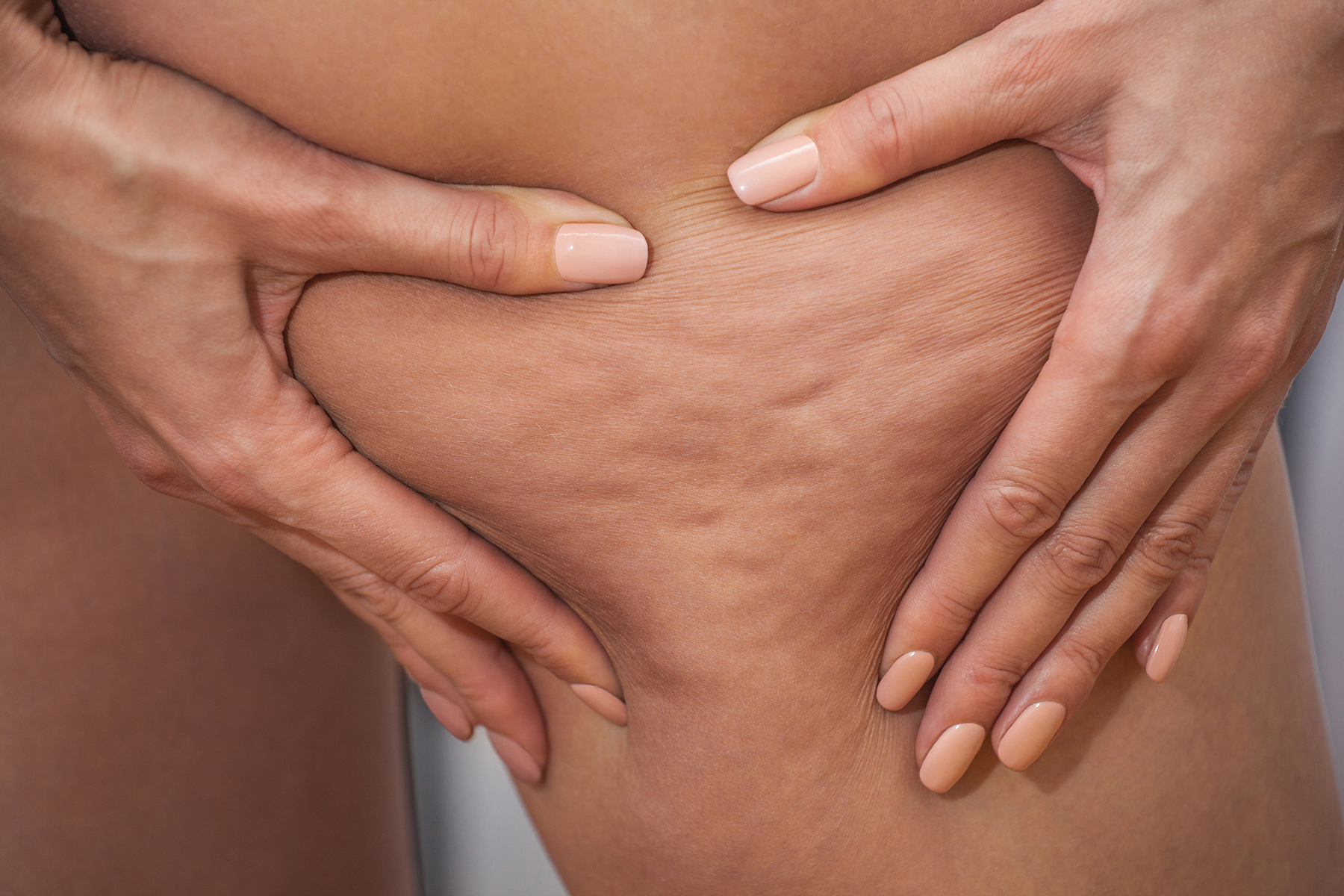These Dimples Aren’t Cute

You eat healthy, you exercise daily, you don’t smoke, and you drink lots of water. You even get the necessary hours of shut-eye.
You follow all the rules. Yet, there is one thing you can’t seem to control — cellulite.
It’s the bane of both thin and overweight women. If you live up north, where you spend most of the year layered in clothing, dimpled skin can be easily hidden. But in South Florida, where tank tops are common and shorts are a must, cellulite is an unfortunate (and unsightly) companion.
If it’s any consolation, cellulite is more common than you think.
Between 80 to 90% of women suffer from orange-peel skin, mostly on their thighs and buttocks, though sometimes it may homestead in the upper arms and abdomen as well. Men, on the other hand, rarely claim it.
“It isn’t about diet or exercise or lifestyle,” explains Brian W. Morrison, M.D., a board-certified dermatologist with the University of Miami Health System. “Those things don’t play a big role. It’s more about hormones than anything else.”
So, the biggest risk factor for those lumps and dimples? Being a woman or what Morrison calls “a high-estrogen state.”
Genetics also play a role. If you mother has it, it’s likely that you will too. Aging tends to worsen cellulite as well because the skin thins and becomes less elastic, causing it to sag.
Despite how commonplace it is, cellulite remains a mystery. We do know this: it appears to involve the connective tissue under the surface of the skin and the layer of fat just below it. The puckering results when the fat pushes against the connective tissue, creating a bulge in the skin.
What’s more, women’s fat cells and connective tissue are arranged vertically, while men have a criss-cross structure. Some experts hypothesize that this may be the reason why most men don’t have cellulite.
Morrison assures his patients that cellulite is nothing to worry about.
“It’s purely cosmetic,” he says, “and it affects almost everybody. Cellulite is never going to have any significant medical consequences.”
Most of his female patients, he adds, have accepted their dimpled thighs. For those who don’t, there are some treatment options. None, however, “cure” cellulite. They simply reduce the cottage cheese appearance of the skin temporarily.
“It’s a lot of hit and miss,” Morrison warns, “and I would tell women they really need to consider the cost and the trouble as it relates to the results.”
While there are hundreds of products touting their cellulite reduction properties, most don’t work.
Dr. Morrison added that few experiments have tested the efficacy of these treatments. Nevertheless, if you’re determined to smooth out the cellulite bumps, he recommends starting out with over-the-counter products before moving up to more complex and expensive treatments.
- Try a little self-massage in the affected area every day for several weeks. A rubdown rids the skin of excess fluid and may make cellulite less noticeable. Besides, it’s free and easy to do.
- Look for OTC topical creams that contain caffeine. Some studies have shown that the ingredient that brightens our morning helps tighten skin too. Also, creams with plant extracts might tone up your skin temporarily. Some botanical extracts might include grape seed extract and horse chestnut, even gingko biloba. Like all creams, try out a small spot on your skin to observe how your skin reacts before using it all over your thighs. But don’t expect miracles. Morrison views them as being “theoretically beneficial.”
- Experiment with a retinol cream, preferably a product with 0.3 percent retinol. It might improve your skin’s texture, though it may take months to see the difference. You can also ask your dermatologist for a prescription retinoid cream. “There’s some evidence that it could help,” Morrison says. “They seem to work on a superficial level but not on a structural level.”
- Check out some of the newer, more expensive treatments that show some promise. These include:
Laser treatment may improve the appearance of dimpling skin for as long as a year. One kind, called Cellulaze, uses a tiny laser under the skin to break up the fibrous bands that cause the dimpling. This also thickens the skin, which is how the appearance of cellulite is reduced.
Subcision uses a needle to go under the skin to cut the tethering tissue bands, allowing the dimple to lift up. The vacuum-assisted Cellfina is “one of the more promising techniques,” Morrison says. Results can last about 3 years.
Acoustic wave therapy uses sound waves to “break up” the cellulite. It takes several sessions to see an improvement.
While there are several other treatment methods, such as carboxytherapy, ultrasonic liposcultping, and endermologie, few studies support their efficacy. And the American Academy of Dermatology flat out rejects cryolipolysis, which freezes fat, and mesotherapy, which involves injecting a mixture of substances under the skin. Morrison also suggests patients do their due diligence by researching a treatment’s proven effectiveness and by seeking out a board-certified dermatologist or plastic surgeon.
“In the end, it comes down to acceptance,” he adds. “Those models and movie stars? They have cellulite, too. It just gets airbrushed in pictures.”
In Their Words
Ana Veciana-Suarez, Guest Contributor
Ana is a regular contributor to the University of Miami Health System. She is a renowned journalist and author, who has worked at The Miami Herald, The Miami News and The Palm Beach Post. Visit her website at anavecianasuarez.com or follow @AnaVeciana on Twitter.
Tags: Ana Veciana Suarez, Brian W. Morrison, cellulite, dermatology, laser treatment, skin condition, wave therapy
